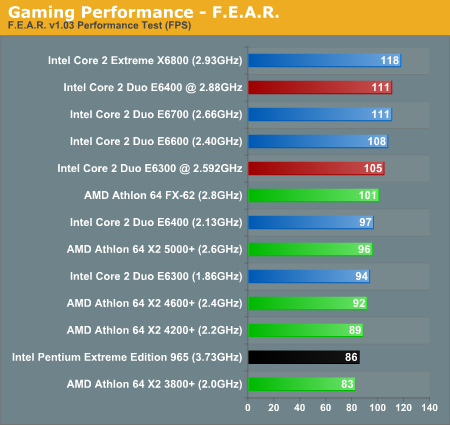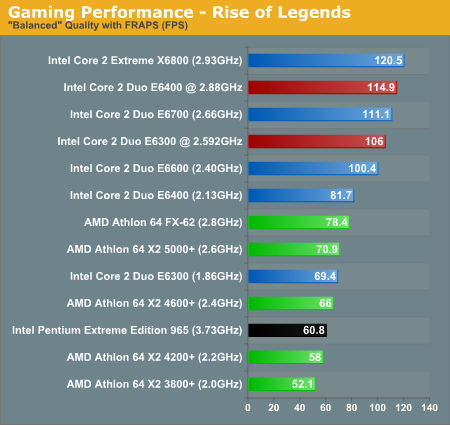Intel Core 2 Duo E6300 & E6400: Tremendous Value Through Overclocking
by Anand Lal Shimpi on July 26, 2006 8:17 AM EST- Posted in
- CPUs
Gaming Performance using F.E.A.R. & Rise of Legends
Our F.E.A.R. test should be fairly familiar by now, as it is the built in performance test included with the game. Computer settings were left at "Maximum" while the graphics settings were set to "High" with the resolution cranked up to 1600 x 1200. F.E.A.R. ends up still being more GPU than CPU bound at these settings, even with a pair of X1900 XTs at its disposal, but we do see some separation among the processors:

We mentioned that F.E.A.R. is more GPU limited than many other titles, but without antialiasing enabled the spread is still 42%. As with many other games, the Core 2 Duo chips outperformed their AMD counterparts in terms of price/performance. However, it's questionable how many people would purchase a $200 CPU to pair up with over $1200 worth of motherboard and graphics cards. That doesn't mean the Core 2 Duo isn't faster, but you will certainly need a very powerful graphics chip in order to realize the potential. On the flip side, the extremely strong performance of an overclocked E6300/E6400 means you can spent more money on your graphics setup if you're a gamer and get close enough to the speed of a X6800 through overclocking to drive those high end GPUs.
Rise of Legends is a newcomer to our game benchmark suite and what an excellent addition it is. This Real Time Strategy game looks very good and plays well too; it serves as good filler until the next Command & Conquer title eventually arrives for those looking for an RTS fix. We ran with the resolution set to 1600 x 1200 and the graphics settings set to the medium defaults. We recorded a custom demo of a 3 vs. 2 multiplayer battle and played it back at 4x speed, recording the average frame rate for 10 minutes of the battle. The 10 minutes we focused on contained a good mix of light skirmishes between opponents, base/resource management with very few characters on the screen and of course some very large scale battles. As with most RTSes, Rise of Legends is extremely CPU bound. The performance variability between runs was fairly high in this test, mainly because of how disk intensive the playback can get. Differences in performance of up to 5% should be ignored.

Rise of Legends is clearly a game that demands a lot from the processor, and the additional cache in the 4MB Core 2 Duo chips also appears to have more of an impact in this game than in other games. The only Core 2 chip that AMD's FX-62 is able to beat is the "budget" E6300. If other RTS games perform similarly, strategy gamers will definitely want to upgrade to Core 2. Once again we see that overclocking the E6300 and E6400 get you fairly close to the higher end E6700 and X6800 Core 2 processors; with performance like this, why bother spending any more on a faster Core 2 CPU?










137 Comments
View All Comments
bob661 - Wednesday, July 26, 2006 - link
Give me a break dude the Intel fanbois were doing the same thing. Nothing to see here. Move along.araczynski - Wednesday, July 26, 2006 - link
looks like i'll be gettig the E6600 for great base performance with capability to overclock decently. I'll probably be sticking with a P965 mobo since i won't be going for crazy overclocking or crazy cooling solutions (that turniq cooler looks just about right for my tastes).now i just have to figure out whether to get a 7900gt/gtx/50gtx.... to last me until the second generation of the dx10's comes out...
drebo - Wednesday, July 26, 2006 - link
The pricing in this article is inaccurate. The Conroes are too low and the Athlon64s are too high.Seems to me you're using vendor pricing for one and suggested retail for the other.
coldpower27 - Wednesday, July 26, 2006 - link
No the pricing is completely accurate they are using AMD's price lists that come directly from AMD itself, and they are using Intel's prices for 1000 Unit Quantities, that will also be published on their website.If your talking about actualy price on online retailors that will remain to be seen.
drebo - Wednesday, July 26, 2006 - link
No, I'm not talking about online retailers.I'm talking about actual prices that I can get right now from my distributors and the listed suggested retail prices.
Where, exactly, are you getting your prices?
coldpower27 - Wednesday, July 26, 2006 - link
Go to AMD.com and you can get their official pricing, the listed numbers are what will be on Intel's website when they get updated for Core 2 Duo.OEM Distributer pricing is a different metric.
drebo - Wednesday, July 26, 2006 - link
Distributor pricing is what determines street and retail pricing.Intel can post the MSRP of $999 all they want, but if distributors are selling their products for more than that, the price will never be seen.
What matters is that these prices are not accurate, and paint an entirely different story than should be painted.
goinginstyle - Wednesday, July 26, 2006 - link
Neither are the AM2 prices currently as most places are selling the FX62 well above the $799. So what was your point? It is all about supply and demand, the same thing happened when AMD launched S939, the prices were way over the stated numbers by AMD. You have to start with a base, the published pricing is the base.
drebo - Thursday, July 27, 2006 - link
Genius, $799 is not MSRP for the FX-62. $799 is the price at which AMD sells the processor to its distributors. The distributor then sells the processor to retail and/or wholesale outlets with a markup. The retailers and wholesalers then sell the same product with yet another markup. Currently, my price for an FX-62 is $811. MSRP is near to $1000, but then I, and many other sellers, do not use MSRP. I use cost-based pricing.
I'm not trying to prove anything here other than that the prices listed in this article are incorrect, and that the conclusions drawn are vastly different than conclusions that could be drawn were the pricings correct.
By the way, all prices I've quoted have been for PIBs, not tray processors. I don't use OEM processors...too much liability.
coldpower27 - Thursday, July 27, 2006 - link
And, that's the thing the prices quoted are correct.
Using distributer pricing isn't a good idea as it could vary between the companies, depending on the deal you got as well, those particular prices can't be verified.
The prices listed on this chart can be since they are listed on AMD site and will be on Intel's.
There isn't a choice, unless you wish to use the real world pricing floating around as that is what matters at the end of the day, but there are issues with that, as that fluctuates.